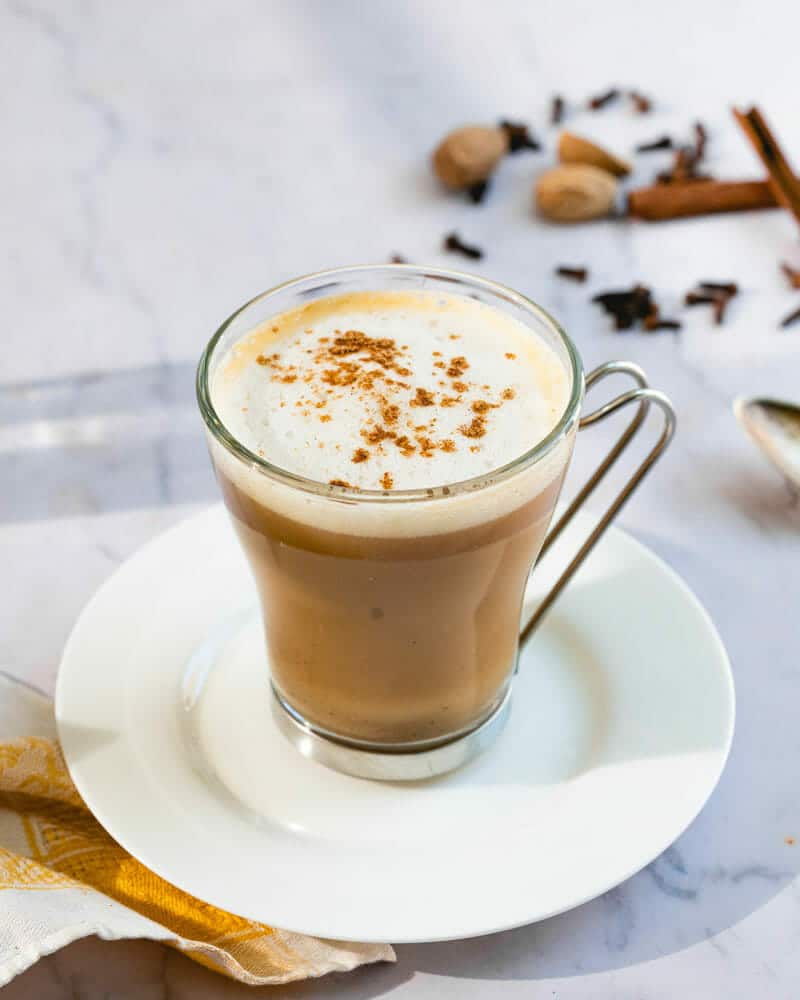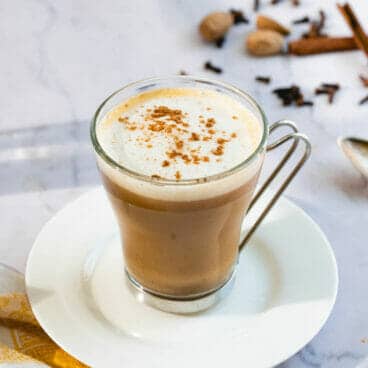Here’s how to make a vegan chai latte as good as a coffee shop! There’s a secret to getting the perfect foam topping with dairy free milk.

A great chai latte doesn’t need dairy milk. Meet the perfect Vegan Chai Latte! It’s warm and cozy spiced, lightly creamy with a fluffy foam topping. And honestly, that’s a feat! Dairy free milks can act more like water than milk. So this vegan latte: it’s a revelation! It’s just sweet enough with the perfect intrigue from the chai spices. It’s much lighter than a typical latte, so you don’t feel like you just ate a bowl of ice cream. Here’s the trick you need to know to make a vegan chai latte!
How to make a vegan chai latte: the secret!
So what’s a chai latte, anyway? The chai latte is a cultural fusion: it combines traditional masala chai, a milky spiced tea from India, with frothy steamed milk of a cafe latte. This started to become popular with second wave coffee shops in the 1990s (read: Starbucks). Most coffee shop versions of chai have little left of the traditional Indian tea, making it too sweet with too many spices.
This vegan chai latte is just sweet enough, and gently spiced with a blend of chai spices. Even better, you can get that beautifully frothy top! Most vegan chai latte recipes simply add coconut whipped cream to the top as a faux foam. But this recipe actually works! The secret? Oat milk.

What’s the best milk for a vegan latte?
We’ve done the research so you don’t have to! What’s the best milk for a vegan latte? Regular oat milk. Here’s why:
- Oat milk is the best milk for frothing. It’s creamy enough so that you’re able to foam it using the traditional methods. (Almond milk does not hold up.)
- Oat milk has the best neutral flavor. It has a lightly sweet but neutral flavor that’s closer to dairy milk than other substitutes. Coconut milk and soy milk can work for a latte, but they have a stronger flavor.
Oat milk is becoming easier to find and a more popular dairy free milk. Make sure to buy unsweetened oat milk: it has the best flavor. Plus, we’ll be adding sweetner…
The sweetener for a vegan chai latte: maple syrup
This chai latte recipe is intentionally just sweet enough: it’s not a copycat Starbucks recipe that’s packed full of sugar! But don’t worry: it’s sweet enough that it tells your taste buds that it’s a chai latte! Here are a few notes on the sweetener to use for a chai latte:
- The best: pure maple syrup. It has just the right caramel-flavored nuance (it doesn’t taste like maple, promise).
- Alternate: agave syrup. If you have it on hand, agave also adds gentle sweetness.
- Optional: simple syrup. Got some on hand for cocktails? It also works for lattes.

DIY chai spices blend
The word chai translates to “tea” in Hindi, so saying chai tea is technically like saying “tea tea.” The more correct term for the Indian tea blend is masala chai. The word masala refers to a blend of spices used in cooking. Just like the word curry, a Westernized reduction of a complex blend of Indian spices, the word chai can oversimplify and appropriate a rich Indian cultural tradition.
Masala chai spices can include many different ingredients based on the cook, just like curry powder. This Homemade Chai Spice mix uses common chai spices, but note there are many more used regionally in Indian blends. Here’s what you’ll need for the chai spices:
- Cinnamon
- Ginger
- Cardamom
- Black pepper
- Nutmeg
- Cloves
- Fennel seed
Traditionally, whole spices are simmered with water and tea to make make masala chai: like whole cinnamon sticks and cloves. This chai spice blend is a shortcut by using ground spices that you might already have in your pantry. It makes the process quicker and easier, and also lets you use the leftover spice blend for baked goods like cookies and muffins.

How to froth milk for a vegan chai latte
Here’s the thing: frothing milk for a vegan chai latter is a little different than with dairy milk. The main difference? You can over-froth the oat milk. That’s right: if you froth too much, it will deflate. Keep in mind that the foam is not quite as creamy as you get with 2% or dairy milk, because there’s less milk fat. Here’s what to know about how to froth non dairy milk:
- Heat the milk to 150 degrees (scalding). The temperature is important for the perfect frothy foam. Use a candy thermometer if you have one. Or, eyeball it: 150 degrees is hot to the touch with some small bubbles starting to form on the outside, but it’s not yet simmering.
- Use a French press, hand frother, or whisk. We used our French press and it worked great. You can also use a hand frother (we use this one), which is even better!. If you don’t have any fancy gadgets, you can vigorously whisk the milk.
- If using a French press, don’t overwhip! With our French press we needed only 25 pumps (compared to 100 pumps for 2% milk). Pump or froth just until you see it becoming fluffy. If you go past that point, the froth will deflate.
Want a regular latte with dairy milk? We got that too. Go to Perfect Chai Latte.

Serving your vegan chai latte
And that’s it! Make your masala chai (see below), then mix in that frothed milk. You’ve got a beautiful vegan chai latte with actual foam, thanks to the oat milk! No need to make extra vegan whipped cream. We like to add a sprinkle of chai spices on top as a finishing touch.
*Want to make vegan chai lattes to order throughout the week? Make a big batch of the spiced tea and refrigerate. When you’re craving a latte, warm up ¾ cup of the tea, then froth the ½ cup milk.
This recipe is…
Vegetarian, gluten-free, vegan, plant-based and dairy-free.
Print
Perfect Vegan Chai Latte
- Prep Time: 10 minutes
- Cook Time: 0 minutes
- Total Time: 10 minutes
- Yield: 1 large or 2 small lates 1x
Description
Here’s how to make a vegan chai latte as good as a coffee shop! There’s a secret to getting the perfect foam topping with dairy free milk.
Ingredients
- 1 teaspoon Homemade Chai Spices
- 1 ½ cups regular oat milk (unflavored)
- 1 bag black tea (or 1 teaspoon loose leaf black tea in a tea strainer)
- 1 tablespoon pure maple syrup (or simple syrup)
Instructions
- In a small saucepan over medium high heat, whisk together chai spices, 1 cup of oat milk and the tea bag and bring to a boil. Once boiling, remove it from the heat and allow it to rest for 1 minute. Then strain through a fine mesh strainer* into one or two mugs (one for a large latte and two for small).
- Rinse the saucepan. Add the remaining ½ cup milk and maple syrup. Heat the milk to 150 degrees Fahrenheit (measure using a thermometer): this is hot with some small bubbles forming around the outside, but not simmering. The exact temperature is helpful for getting the perfect foam (if you don’t have a thermometer you can approximate).
- Use hand frother, whisk, or French press to foam the milk. The French press is a favorite method: Add the scalding milk to the french press and pump vigorously until frothy, about 25 times. Do not overwhip, as the foam will deflate! (Go to How to Froth Milk for more.)
- Pour the milk and foam evenly between the mugs (or into 1 mug). Sprinkle with additional chai spices and serve.
Notes
*You can skip straining if desired: the spices will settle to the bottom of the drink.
- Category: Drink
- Method: Stovetop
- Cuisine: American
- Diet: Vegan
Keywords: Vegan chai latte, how to make a vegan chai latte
More cozy drinks
Here are a few more vegan drinks that are perfect for cool weather! Make sure to try:
- Perfect Tea Latte Go for a straight up tea latte: it’s even easier!
- London Fog A cozy tea latte made with Earl Gray tea and lavender.
- Matcha Latte or Iced Matcha Latte Try these classic green drinks with almond or oat milk.
- Dirty Chai Latte Make your tea latte “dirty” by adding espresso to make it a coffee drink.
- Homemade Hot Chocolate There’s no need for a packaged mix if you’re craving hot cocoa! Also try Peppermint, Spiked, Baileys and Kahlua hot chocolate.
- Mulled Cider or Hot Apple Cider Infused with spices like cinnamon and cloves, you can make it in a slow cooker or on the stove.
- Pumpkin Spice Iced Coffee This vegan pumpkin spiced coffee is perfect for when cozy pumpkin season starts.



